Discover how Tefal increased email-driven sales by 7x through data consolidation, lifecycle-based segmentation, and personalized trigger emails.
Tefal Doubled its Revenue from Direct Marketing Thanks to Customer Base Segmentation, Trigger-Based Emails, and A/B Tests
Challenges
Merge multiple sources with customer details. Boost customer engagement and revenue share attributed to direct marketing
Solutions
Consolidate customer data into a single platform
Segment the customer base, create and implement a communication plan
Carry out A/B tests on campaigns
Segment the customer base, create and implement a communication plan
Carry out A/B tests on campaigns
Results
Email marketing revenue has doubled in comparison to pre-implementation figures
80% of the total direct marketing revenue is now attributed to trigger-based email campaigns
80% of the total direct marketing revenue is now attributed to trigger-based email campaigns
Noteworthy features
20 A/B tests launched alongside trigger campaigns at the start of the project
Immediately upon integration with the CDP, Groupe SEB — owner of the Tefal brand — consulted Maestra to boost their direct marketing revenue. The team decided on an innovative approach where campaigns were A/B tested to find the best fit during their initial launch. This differs from the traditional approach where you set up standard campaigns, launch bulk emails, and only then begin to personalize them. Groupe SEB Marketers started to build a model of the customer communication process using the customer base of Tefal — the largest brand in the Group.
We’d like to share with you:
- What we achieved by consolidating customer data and implementing a new communication strategy;
- Why we chose Maestra;
- How we segmented the customer base based on life cycle and created a communication plan for each segment;
- Our experience with A/B tests: why we launched trigger campaigns simultaneously with A/B tests, the insights these tests provided and how they can be applied to online and offline sales.
Implementing the Marketing Automation Platform and Re-Designing Direct Communications: The Outcomes
Growth rate: revenue attributed to personalized trigger scenarios in direct email marketing relative to the total revenue of the online store
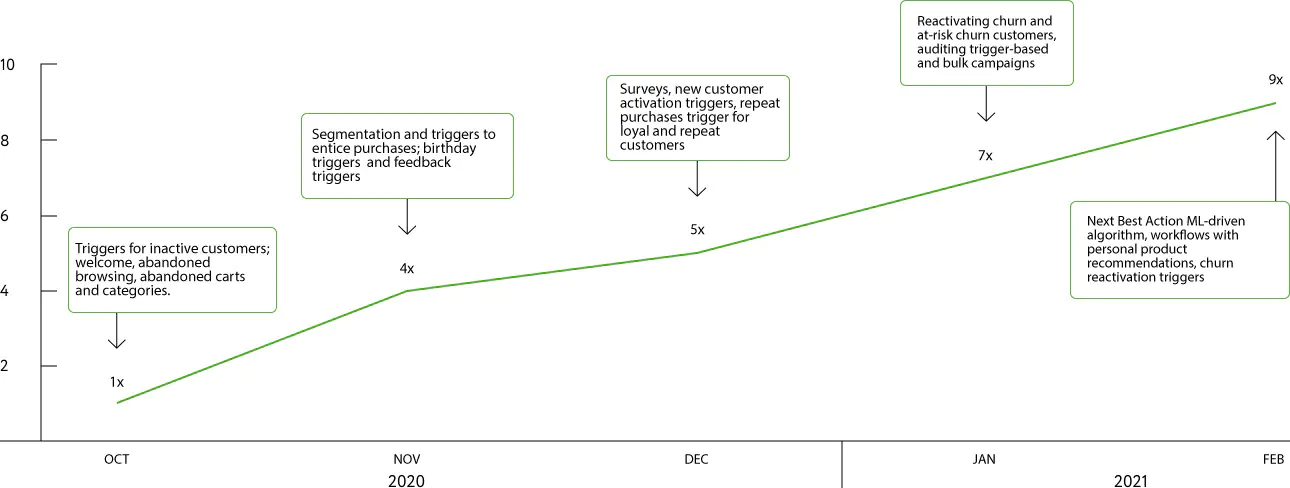
Five months after implementing Maestra, email-attributed revenue increased by 7 times. The average monthly email revenue doubled compared to pre-implementation figures. Due to the new trigger campaigns, revenue continues to grow steadily each month
Share of revenue generated by trigger-based emails relative to the total direct marketing revenue

The share of revenue from trigger-based campaigns relative to the total direct marketing revenue increased from a mere 2% to 80% in just 5 months. This came as a result of adding 23 trigger campaigns (where there were none previously). Triggers help automate campaign personalization, saving marketers hours of work, and communicating with customers at the right time. The data for this chart was collected using last-click attribution
This is the first time I’ve worked with an company that is so proactive. Maestra team members make it their job to suggest, advise, and provide super fast support, and celebrate positive results with us.
The important part is that Maestra regards its client’s business as its own. So, it’s not as simple as launching a task in Basecamp — working on it, declaring it impossible to complete, and then just quitting. Instead, we combine our efforts in solving challenges, boosting KPIs, and analyzing results. “I can’t do that” simply does not exist for us. The team always makes sure to come up with alternative solutions, and that is what I appreciate the most.
We plan to improve our campaigns by delivering “smart” segmentation based on purchase history and deep customer behavior analysis.
My overall opinion and experience are incredibly positive. However, there was one fly in the ointment — integration. Though through no fault of the consultant’s nor the manager’s, the time it took — two months — was too long. I understand that this all depends on a client’s IT team or (like in our case) a client’s partner’s IT team. However, I would have liked for this issue to have been resolved sooner. My ideal plan was to launch our marketing communications in September, whereas these had to be launched in late October instead. Fortunately, we at Groupe SEB have a friendly and positive working environment. There was no pressure put on me by my management. Instead, I was continuously and reasonably doing what I could to help the project progress smoothly. However, I’m sure there are companies where the situation would have turned sour.
Integration expectations really do matter. Integration is just a milestone or the end goal — its centered around each client’s campaign plan. Maestra’s Customer Success Manager creates an integration brief based on this plan within the client’s first 3-5 days with us. After that, a lot depends on our client’s IT team or their partner’s IT team. To speed up the integration process, you can:
— Show Maestra’s documentation to your IT team. This will allow the integration team to analyze Maestra’s API before the project’s inception and prepare their questions.
— Split the integration into milestones to avoid getting overwhelmed by trying to complete everything at the start. Even with just a portion of the integration blueprint completed, it is often possible to launch the first campaigns. Then the team can proceed to the next integration step while preparing new campaigns at the same time.
— Sync the integration plan with the date when the integration team will actually be able to get started. Usually, in-house IT development resources are scarce and expensive. Thus, some departments may have to wait in line for an allocated IT sprint for the integration. This is why it’s important to align the date when you want to get started with Maestra with when your team will have all the necessary resources available.
Challenges and Solutions
Before implementing the marketing automation platform, Groupe SEB used to store customer data separately: this included retail stores, seven online stores of multiple brands, and service centers. We understood that our regular customers were the loyal audience that could help us form the right business proposal and whom we want to communicate with. This is why we decided that the best first step would be to consolidate all customer data in one platform to see how many unique customer records we have and what data each of these records contain.
The next milestone was communication. Groupe SEB started working on direct marketing communications with the Tefal customer base as it had accumulated the lion’s share of customer data. This paved the way to setting up a large business segment and testing multiple campaigns. The data and insights from the Tefal project apply to other brands of Groupe SEB as well, such as Moulinex, Rowenta, and KRUPS.
Selecting The Platform
We sifted through a large pool of various marketing automation platforms.
In our case, the price was the first and foremost important aspect. Maestra has the most attractive rates compared to its competitors. CRM is on everyone’s annual KPI plan. However, CRM marketing is just a drop in the ocean of our overall marketing efforts. Its share in the plan and KPIs is not that large, so we were looking for a way to reduce costs where possible. This was the first important aspect we planned to find a solution to.
Transparency was another key criterion for us. With Maestra, we know exactly what we are paying for — no hidden costs. The only black box for us was consulting, since I have no experience with email marketing and CRM in this particular field. But we decided to go ahead and try things out. We were looking for a team with capable hands and insightful minds.
The third important task was to implement straightforward, logical pricing with a modular approach. Some products were delivered with a free two-week trial period. This came in really handy and made Maestra stand out.
The fourth aspect we focused on was having a good reputation based on a large amount of successful cases. As we know, nobody usually writes about their unsuccessful cases and usually we only see the good ones. However, bad cases have a much bigger impact, even with them being far fewer. Maestra has relevant market summary figures. So when I lacked benchmarks, our Maestra consultant shared their 2020 analytics in multiple industries. I saw that they could not have been derived from only one or two cases, since those with less experience and expertise weren’t likely to have so much data and research at hand.
Finally, we focused on the aspect of functionality. Maestra offers unique modules that we are too fledgling a company and aren’t established well enough to use just yet. Still, it is good to know that you can connect with them anytime without having to look elsewhere
Segmentation and Communication Model
The RFM (Recency, Frequency, Monetary) model was used to better understand and manage customer behavior. Using this model, the customer base was divided into 5 distinct segments:
- New customers: registered less than 30 days ago, no orders;
- New, but at-risk churn customers: registered 30+ days ago, no orders;
- Loyal customers: 1+ orders, who last purchased up to 60 days ago;
- At-risk churn customers: 1+ orders, who last purchased 60–100 days ago;
- Churn customers: 1+ orders, who last purchased over 100 days ago.
An individual communication plan was implemented for each segment depending on customer behavior. Examples of these segments could be when a customer registers, leaves the website without any purchase, makes an order, or has not purchased anything for a long time. Automated workflows help stimulate new customers and active buyers to make purchases and revive churned customers.
Each communication scheme also contains machine learning-driven emails with the Next Best Action (NBA) algorithm. This determines when it would be best to send a campaign. An additional feature was also added to validate customer contact details to ensure that the database is clean with legitimate data at all times.
Campaigns by Segment
New customers
Loyal customers before order
Loyal customers after order
Churn with orders
Churn without orders
All segments
Welcome email series
Abandoned cart
NPS survey
Reactivate Churn-risk
Reactivate with a survey
Birthday
Abandoned item browse
Ask for feedback
Revive Churn
Send a promo code after the survey
Revive interest in non-readers
Abandoned category browse from multiple devices
NBA-based products offer
Collect data
Reactivate those in doubt
Collect data
Message Content
Once the customer base was segmented, message content was then prepared before activating the trigger-based campaigns. To ensure our trigger-based email sequences were effective, we focused on the email subject and header, layout frames, the message intro, as well as the products, URLs, and CTAs we wanted to include. Each email must be unique with relevant contents that help the campaign reach the desired target. These might include promo codes, links to item pages, YouTube videos, or surveys. Finally, email briefs were created for the agency to use when creating emails.
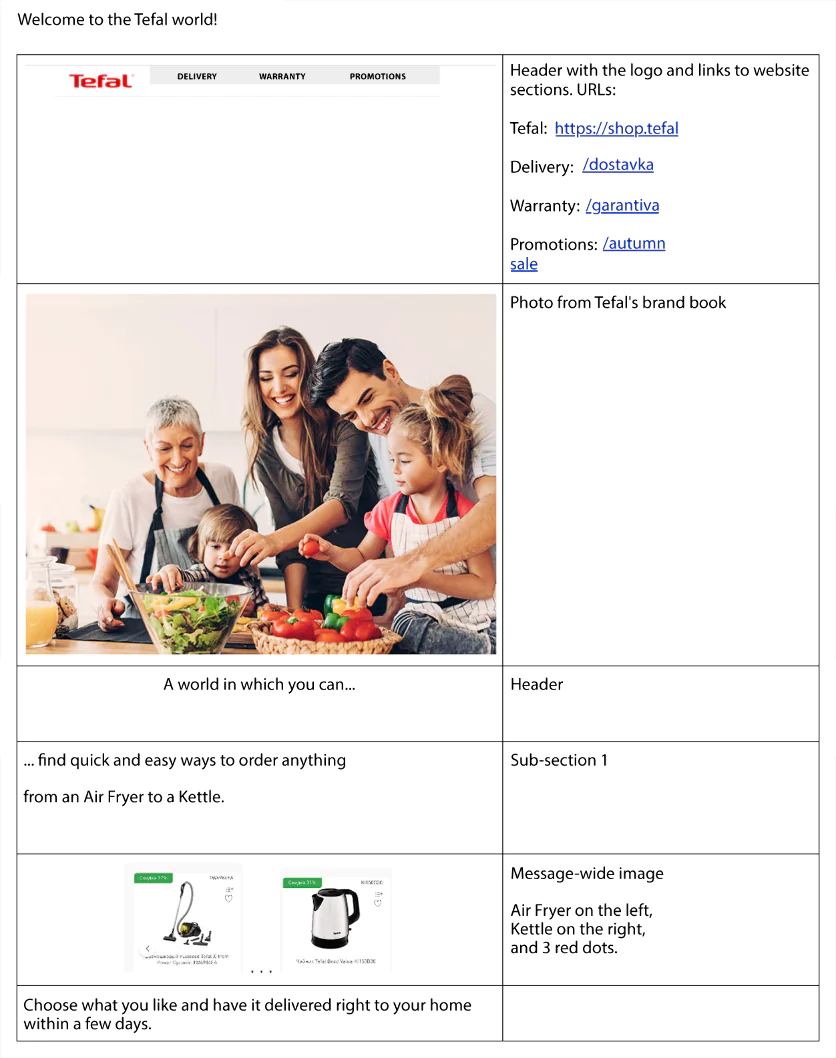
Message brief suggested by Maestra’s consultants
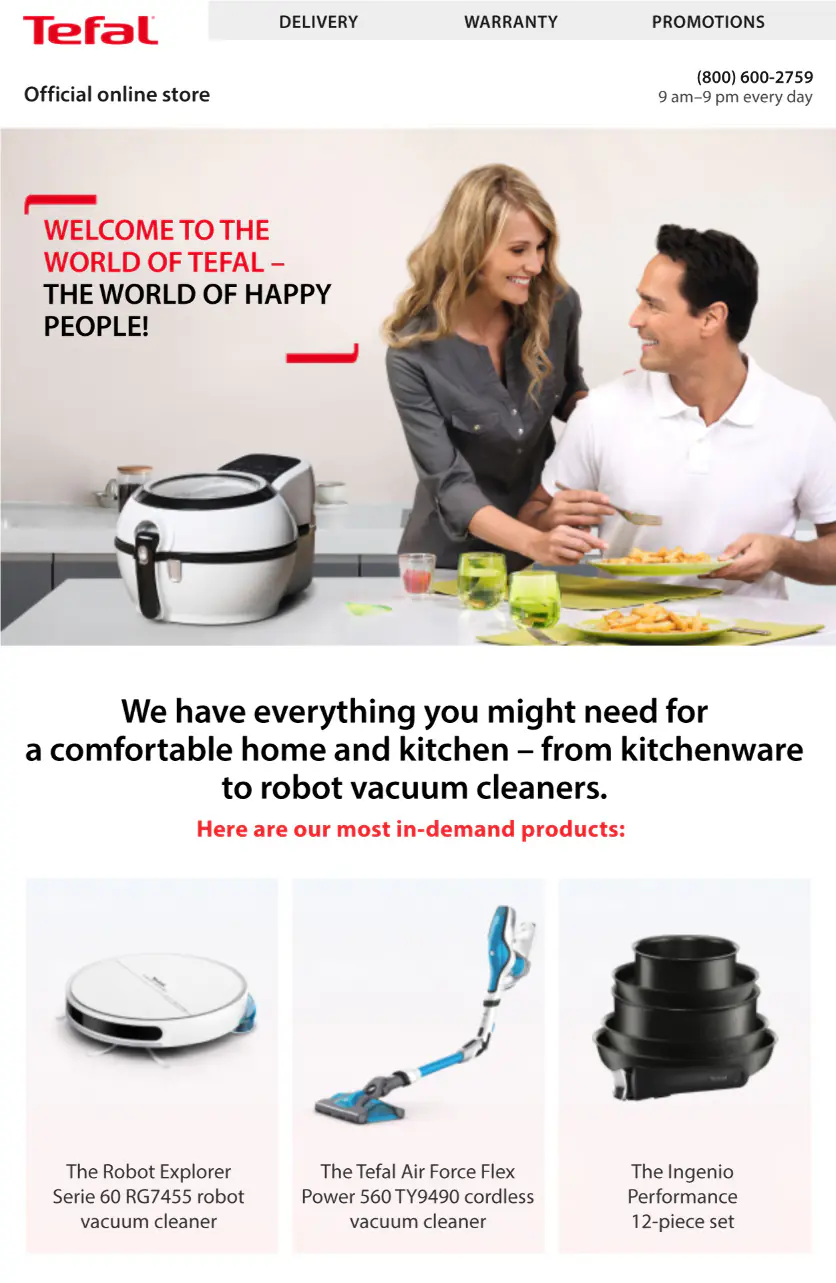
Sample of what the final result might look like
Trigger-Based Campaigns
-
19trigger-based campaigns activated over the course of 5 months
Trigger-based campaign sequences can contain multiple emails, all aiming to stimulate purchases. These campaigns can include include welcome, abandoned cart, abandoned browse, and churn revival emails that are delivered with a relevant offer at the right time. For example, an email with a promo code can be sent after a campaign with new products is unsuccessful.
We also track the number of deliveries, revenue, open rate, and click rate for each message. This helps evaluate its effectiveness and effect on customers. In the welcome series, click rates gradually decrease with each new email, with the exception of the third message which has the lowest metrics. This message is then a weak link and needs readjustment, while the others sustain the desired outcome:
Welcome Email Series for New Customers
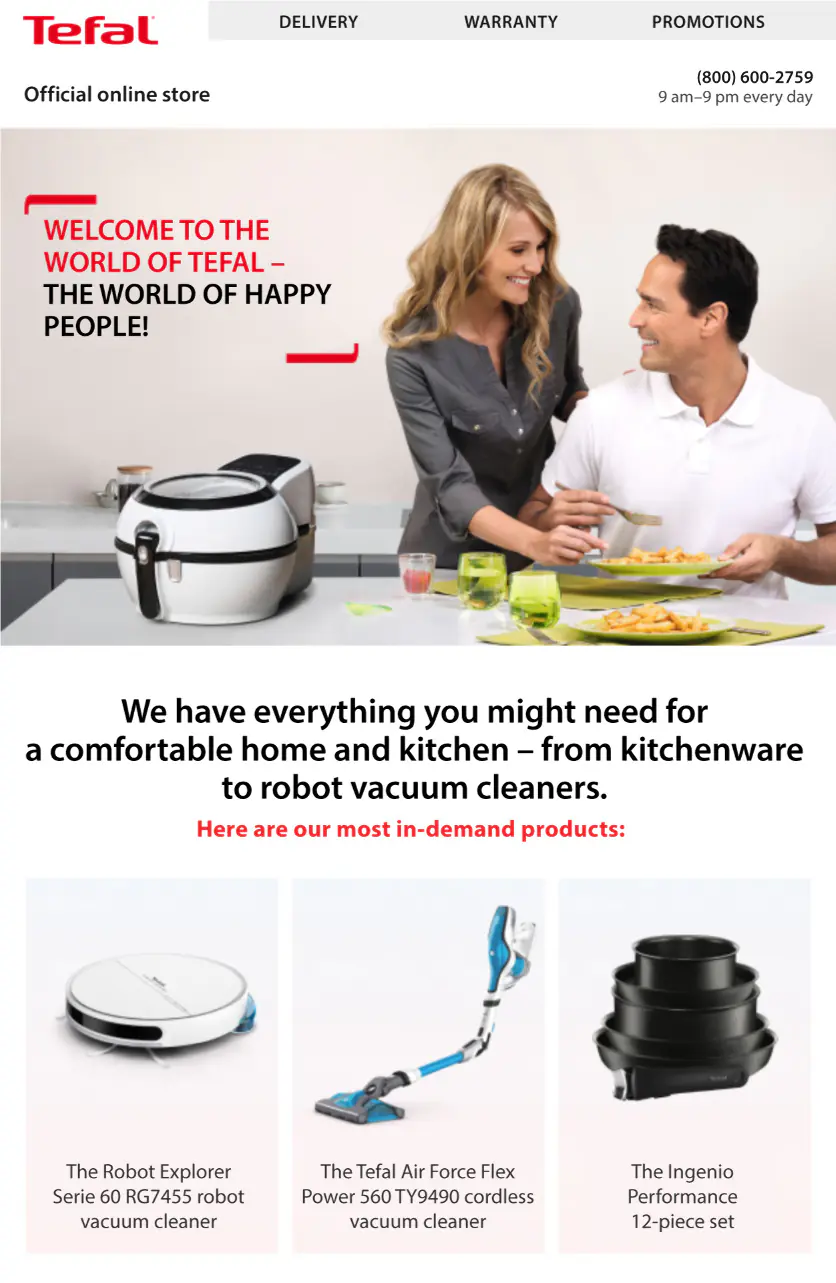
Welcome 1
Once the customer registers on the website, they get this welcome email with a selection of popular products
Once the customer registers on the website, they get this welcome email with a selection of popular products
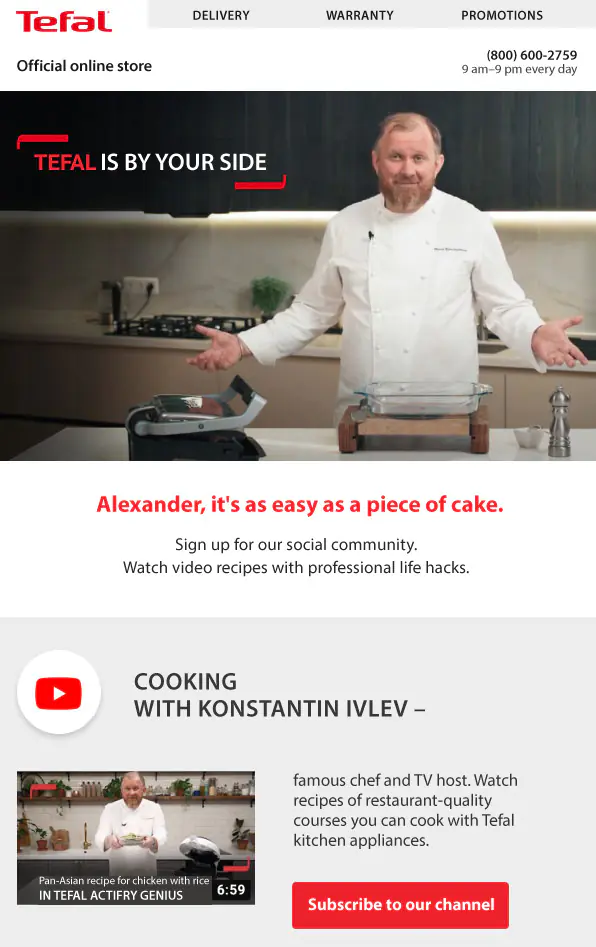
Welcome 2
If the customer has not made a purchase, the trigger-based workflow will send a message that includes delicious recipes with links to YouTube &Instagram, and a new selection of popular items
If the customer has not made a purchase, the trigger-based workflow will send a message that includes delicious recipes with links to YouTube &Instagram, and a new selection of popular items
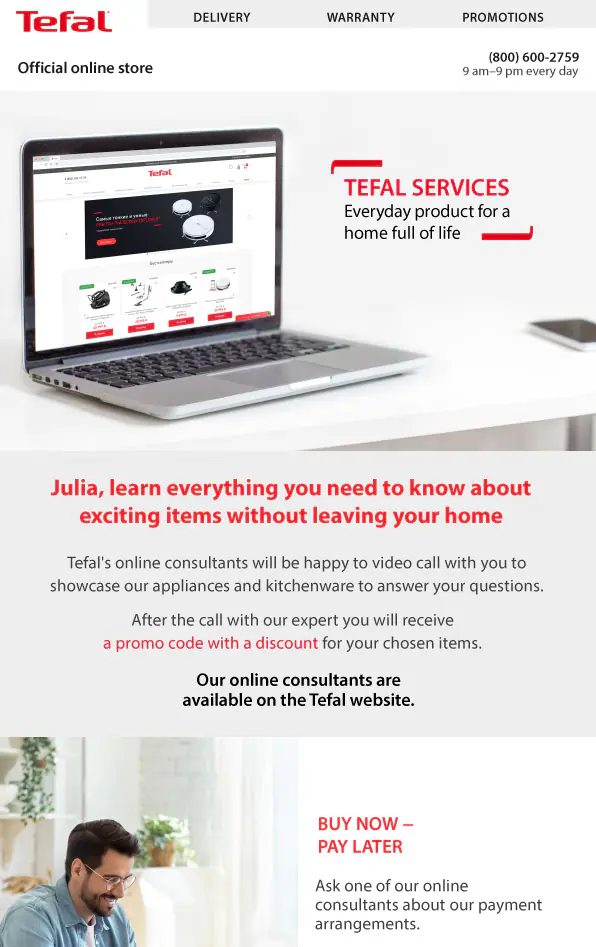
Welcome 3
The next email in the series offers customers help with selecting the right items for their needs and informs them on how to contact the service center. It also contains info on delivery and returns
The next email in the series offers customers help with selecting the right items for their needs and informs them on how to contact the service center. It also contains info on delivery and returns
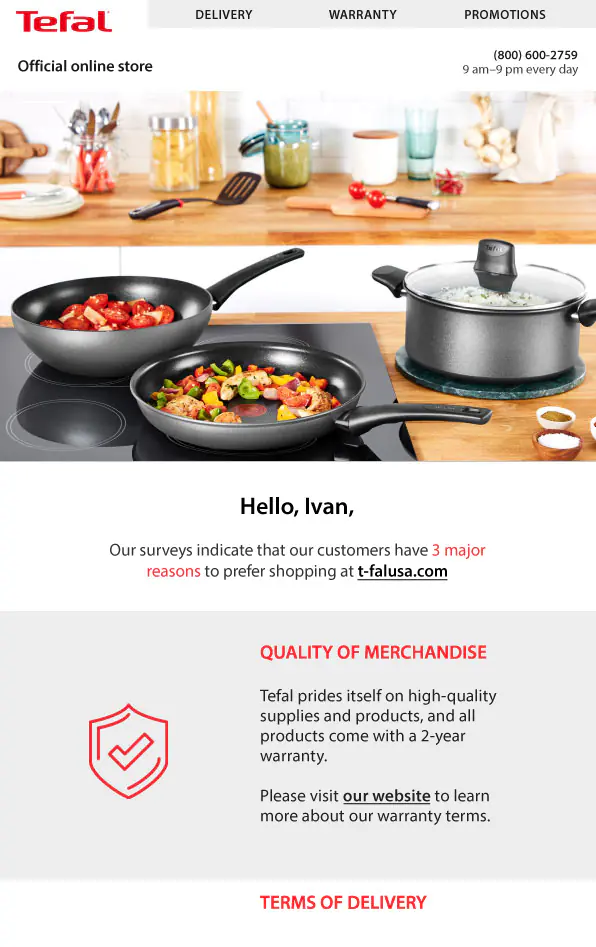
Welcome 4
If the customer is still hesitant, the platform sends out the final email in the series, describing the benefits of owning a Tefal product and offering a promo code
If the customer is still hesitant, the platform sends out the final email in the series, describing the benefits of owning a Tefal product and offering a promo code
The communication workflows also contain survey emails designed to gather more customer feedback and evaluate how happy they are with their purchase or why they haven’t yet made one.
Reviving Interest of New, but At-Risk Churn Customers with Surveys
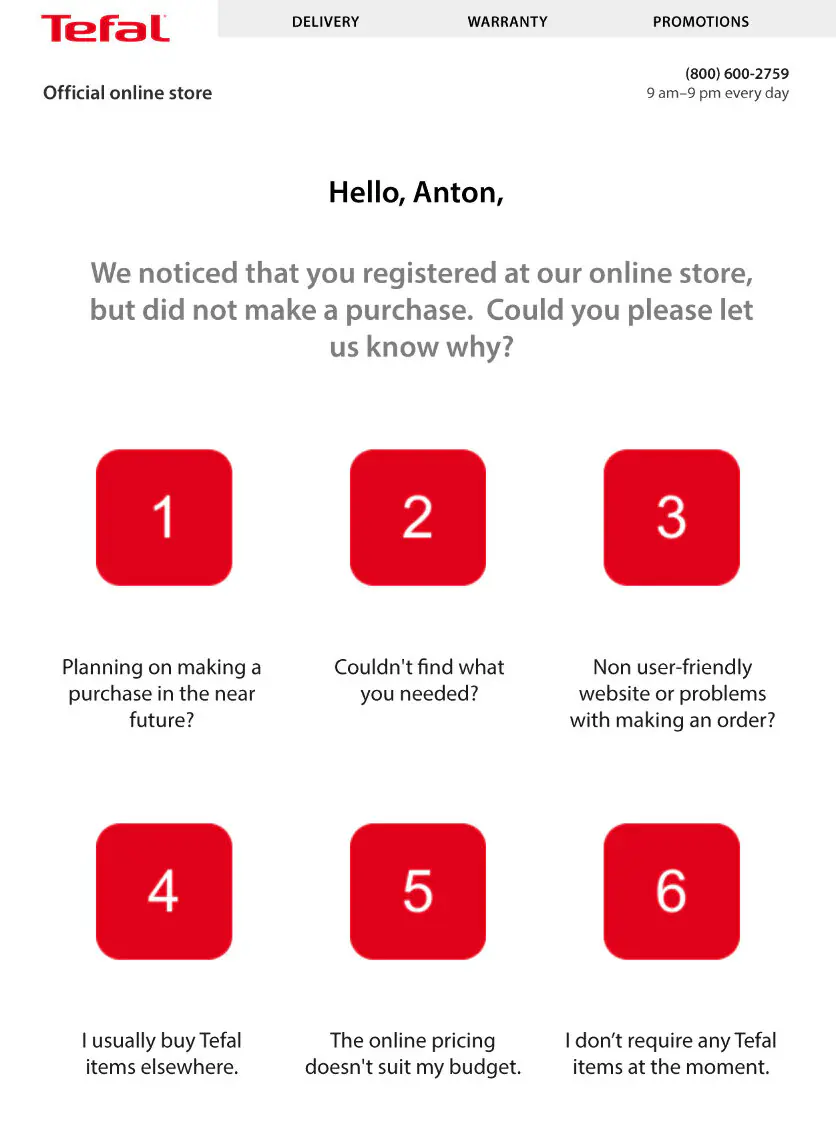
A survey provides insight into why the customer did not make a purchase. On average, 15% of customers take the survey
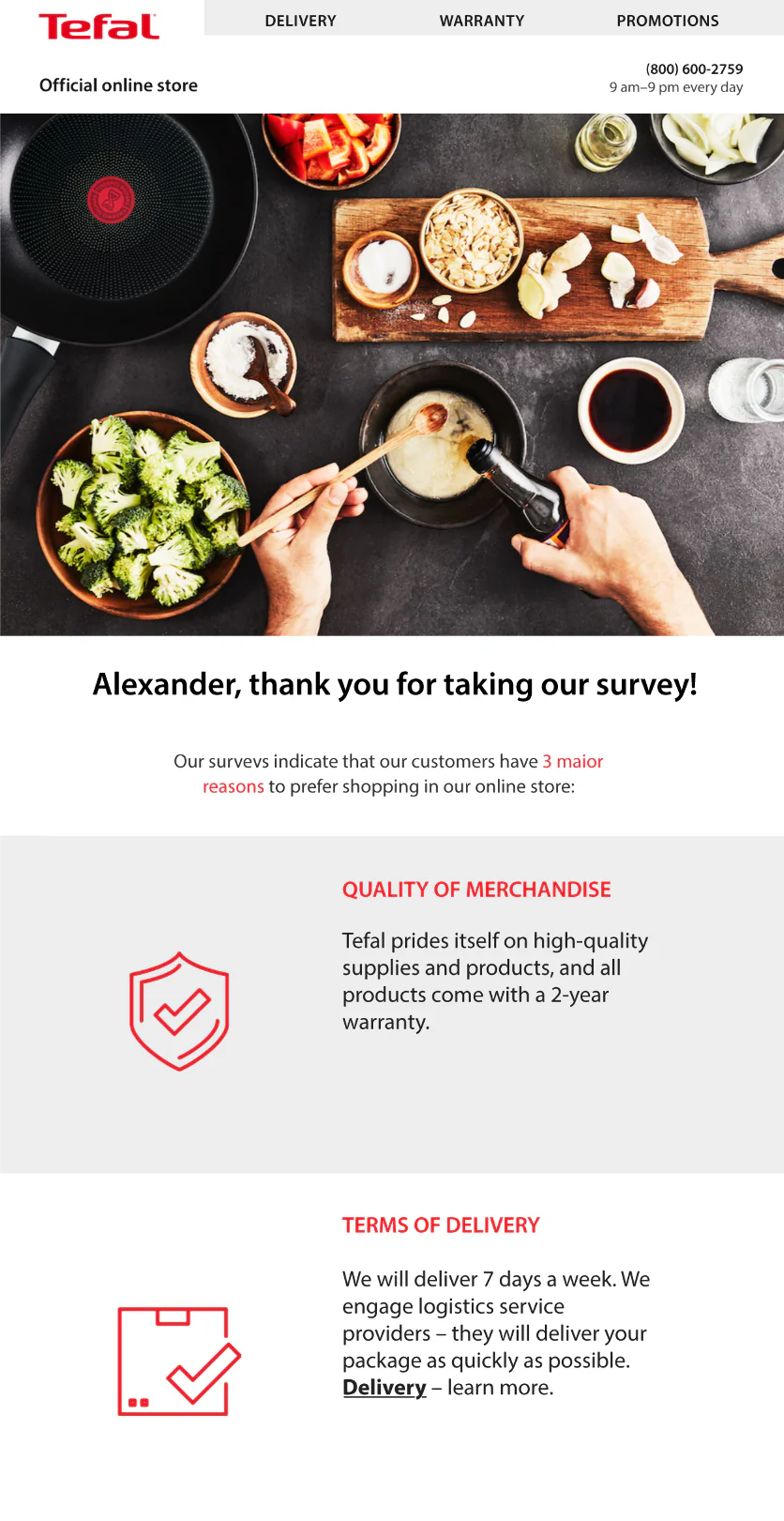
After taking the survey, the customer gets a promo code for a discount
Surveys for Loyal Customers Offered After Purchases (NPS)
Once an order has been completed, each customer is asked to rate the service from 0–10 points — 0 being the lowest and 10 being the highest, with 7 &8 considered neutral scores that will not be counted. To calculate Net Promotion Score (NPS), the following formula is used:

The results of the NPS determine if Tefal customers are satisfied with the service and where there is room for improvement. Follow-up scenarios for such surveys are trigger-based. So, the company has a tool to promptly act upon receiving a negative response and to mitigate its effect. Enthusiastic customers are offered to share their positive experiences by leaving an online review.
Whenever a customer’s response is between 0–3 (negative) or 4–6 (complaint), the tool auto-generates a technical request to the store’s quality control department. They contact the customer, learn more about the problem, and resolve it. These technical messages are broken down into two scenarios as the two score ranges require different levels of urgency from the quality control team.
It is only when a customer is totally satisfied (with a score of 9–10) or enjoyed the service they received overall (with a score of 7–8) that we ask them to leave a review.
A/B Tests
-
20A/B tests were performed simultaneously with the launch of trigger-based campaigns
A/B tests were launched at the same time as the trigger-based campaigns. Usually, A/B tests take place after all basic campaigns are put in place, such as triggers related to abandoned carts, abandoned items browsed, or abandoned categories browsed. Here, messages were sent and tested simultaneously.
For the A/B test, the team chose a customer base segment and relevant campaigns. Then they came up with some hypotheses as to what could result in higher open and click rates. Finally, they calculated the sample size, launched the test, and got their results and insights.
Test results are used to review campaign content and help anticipate the preferences of customers in the chosen segment. In particular, one A/B test showed that customers with no purchase history are more willing to participate in surveys, whereas those with a purchase history value promo codes more.
Segment
Tested hypothesis
Variants
Open rate and click rate winner
Churn without purchases
Promo code vs. survey
Variant 1: Email with a survey
Variant 1 with a survey
Churn with purchases
Variant 2: Email with a promo code
Variant 2 with a promo code
Sometimes emails include ads with celebrities, e.g., from showbiz. There was a hypothesis that customers would show a better open rate and click rate for messages with a celebrity name in its subject. The hypothesis failed. The open rates were the same, while the click rate was 80% higher for messages with a customer’s name in the subject line.
Segment
Tested hypothesis
Variants
Result
All segments
Message subject
Variant 1: Subject mentions a celebrity’s name
Variant 2 with the customer’s name in the subject line improved the click rate by 80%. However, the open rates showed no statistically significant difference
Variant 2: Subject contains the recipient’s name
Every single campaign is launched with an accompanying A/B test. These tests are usually about the business as a whole, rather than about a specific email.
Surprisingly, emails with a video are received a little better, even though these videos are placed at the bottom of the email. As we have to make tons of landing pages, this insight has helped us make the decision to keep adding videos to these pages as well. This is despite the fact that there is a belief in e-commerce, where the less information you provide, the closer your customer is to the target action. If we’re talking about the “buy” step, then it seems obvious that this does not need a video. However, it seems that our customers do click and watch, so we will continue to put videos on our landing pages.
Another example: we A/B tested emails where we had put an “As Seen On TV” label on items that had appeared in TV ads. The first A/B test showed a higher conversion for such messages, whereas the second showed the opposite. We are about to run new tests to get a more accurate assessment. These insights are vital for our offline communications.
Creating Point of Sale Materials (POSMs) for a store takes a lot of time and effort for the whole department. Additionally, there is too limited a space for all the information we’d like to include. There had been debates on whether to put an “As Seen On TV” label on POSMs or fill the space with more distinctive features of the items. So, if the A/B tests with emails show a positive reaction to mentioning TV ads, we might use this insight for our POSMs or e-commerce.
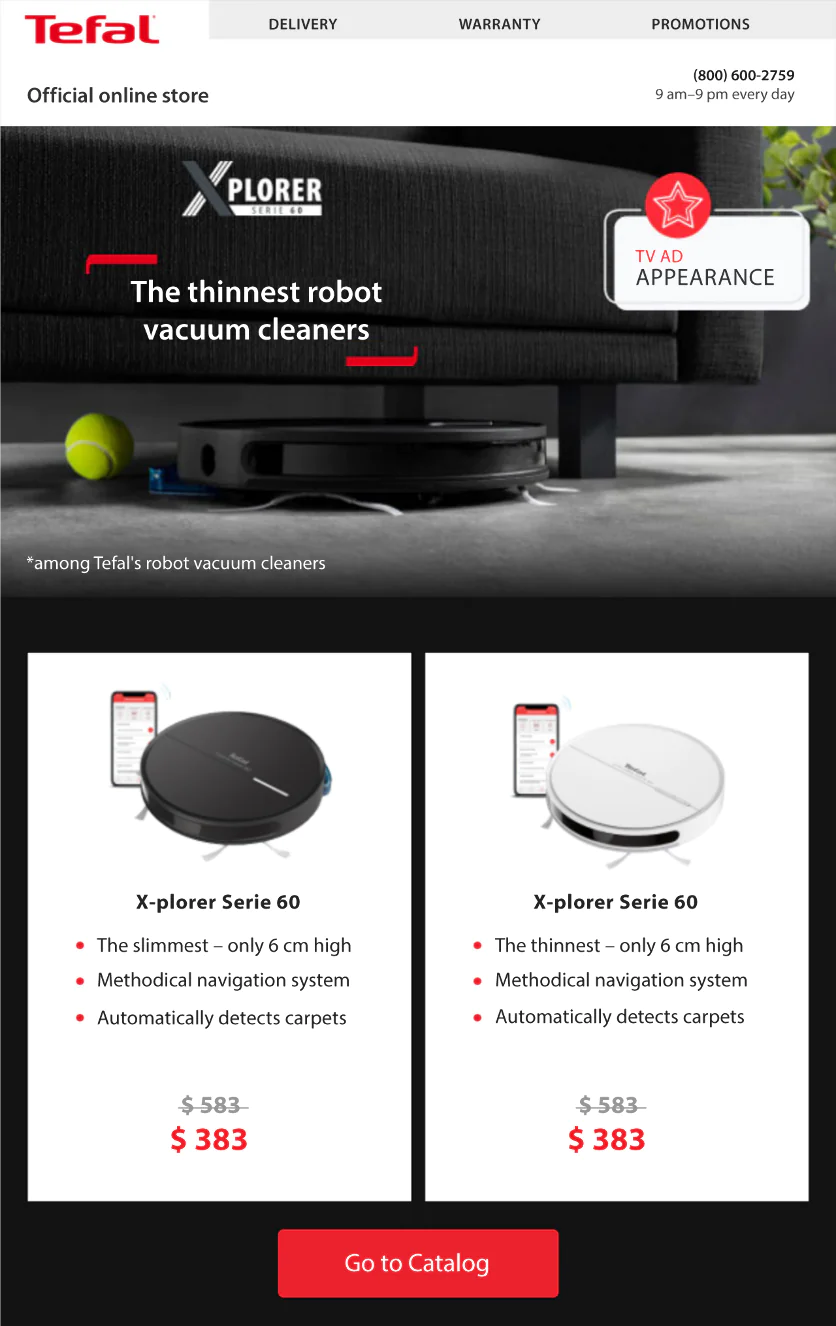
If we see a higher conversion for campaigns with “As Seen On TV” labels in our A/B tests, we will then apply this insight to our POSMs or e-commerce
Plans for Direct Marketing Development
1. Create segments that are more targeted and set up personalization based on purchase analysis. Purchase tracking helps to profile customers: who they are, what they prefer, and what else we can offer them.
2. Set up cross-channel communication and determine the best communication channel for each customer or segment. If a customer doesn’t open emails, they might be more inclined to open an SMS, a WhatsApp or a Telegram message. If they still do not read any messages, this might mean that the only valid communication channel for them is a mass media campaign.
3. Apply the same workflow-based campaigns that proved effective for Tefal to other brands belonging to Groupe SEB.



